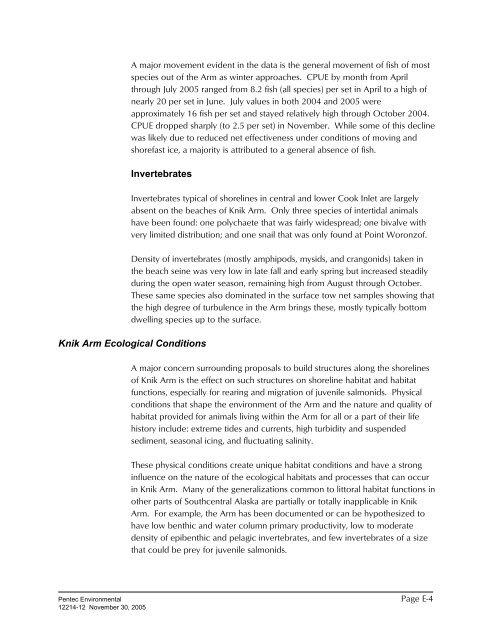Marine Fish and Benthos Studies - Knik Arm Bridge and Toll Authority
Marine Fish and Benthos Studies - Knik Arm Bridge and Toll Authority
Marine Fish and Benthos Studies - Knik Arm Bridge and Toll Authority
Create successful ePaper yourself
Turn your PDF publications into a flip-book with our unique Google optimized e-Paper software.
A major movement evident in the data is the general movement of fish of most<br />
species out of the <strong>Arm</strong> as winter approaches. CPUE by month from April<br />
through July 2005 ranged from 8.2 fish (all species) per set in April to a high of<br />
nearly 20 per set in June. July values in both 2004 <strong>and</strong> 2005 were<br />
approximately 16 fish per set <strong>and</strong> stayed relatively high through October 2004.<br />
CPUE dropped sharply (to 2.5 per set) in November. While some of this decline<br />
was likely due to reduced net effectiveness under conditions of moving <strong>and</strong><br />
shorefast ice, a majority is attributed to a general absence of fish.<br />
Invertebrates<br />
Invertebrates typical of shorelines in central <strong>and</strong> lower Cook Inlet are largely<br />
absent on the beaches of <strong>Knik</strong> <strong>Arm</strong>. Only three species of intertidal animals<br />
have been found: one polychaete that was fairly widespread; one bivalve with<br />
very limited distribution; <strong>and</strong> one snail that was only found at Point Woronzof.<br />
Density of invertebrates (mostly amphipods, mysids, <strong>and</strong> crangonids) taken in<br />
the beach seine was very low in late fall <strong>and</strong> early spring but increased steadily<br />
during the open water season, remaining high from August through October.<br />
These same species also dominated in the surface tow net samples showing that<br />
the high degree of turbulence in the <strong>Arm</strong> brings these, mostly typically bottom<br />
dwelling species up to the surface.<br />
<strong>Knik</strong> <strong>Arm</strong> Ecological Conditions<br />
A major concern surrounding proposals to build structures along the shorelines<br />
of <strong>Knik</strong> <strong>Arm</strong> is the effect on such structures on shoreline habitat <strong>and</strong> habitat<br />
functions, especially for rearing <strong>and</strong> migration of juvenile salmonids. Physical<br />
conditions that shape the environment of the <strong>Arm</strong> <strong>and</strong> the nature <strong>and</strong> quality of<br />
habitat provided for animals living within the <strong>Arm</strong> for all or a part of their life<br />
history include: extreme tides <strong>and</strong> currents, high turbidity <strong>and</strong> suspended<br />
sediment, seasonal icing, <strong>and</strong> fluctuating salinity.<br />
These physical conditions create unique habitat conditions <strong>and</strong> have a strong<br />
influence on the nature of the ecological habitats <strong>and</strong> processes that can occur<br />
in <strong>Knik</strong> <strong>Arm</strong>. Many of the generalizations common to littoral habitat functions in<br />
other parts of Southcentral Alaska are partially or totally inapplicable in <strong>Knik</strong><br />
<strong>Arm</strong>. For example, the <strong>Arm</strong> has been documented or can be hypothesized to<br />
have low benthic <strong>and</strong> water column primary productivity, low to moderate<br />
density of epibenthic <strong>and</strong> pelagic invertebrates, <strong>and</strong> few invertebrates of a size<br />
that could be prey for juvenile salmonids.<br />
Pentec Environmental Page E-4<br />
12214-12 November 30, 2005
















